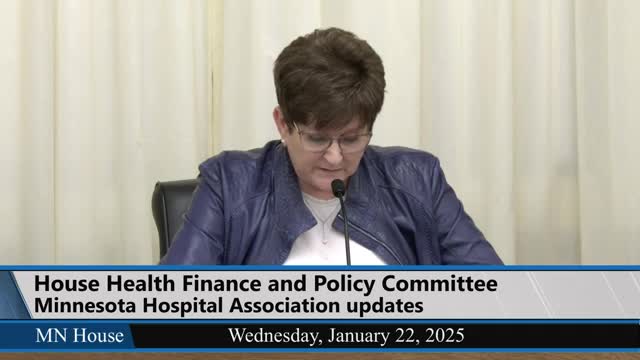Rural hospital faces financial crisis as government reimbursements fail to cover rising costs
January 22, 2025 | 2025 Legislature MN, Minnesota
This article was created by AI summarizing key points discussed. AI makes mistakes, so for full details and context, please refer to the video of the full meeting. Please report any errors so we can fix them. Report an error »

During a recent meeting of the House Health Finance and Policy Committee, significant concerns were raised regarding the financial challenges facing rural hospitals in Minnesota. The discussion highlighted alarming trends in healthcare costs, particularly the impact of government reimbursement rates on hospital operations and patient care.
One of the key issues addressed was the rising expenses hospitals are facing, with labor costs increasing by 5 to 7 percent annually and pharmaceutical prices soaring by 12 to 15 percent. These rising costs are compounded by a shortage of workforce and the inability to pass these expenses onto patients or insurance providers. Hospitals are struggling to maintain financial stability, with one organization reporting a staggering loss of $17 million in 2023, which was only slightly reduced to $12 million the following year.
The committee heard from representatives of Winona Health, the only hospital serving a large geographic area, who detailed the dire consequences of financial strain. They shared that 65 percent of their patient mix is covered by Medicare and Medicaid, which are not reimbursing hospitals adequately for the cost of care. For every 1 percent increase in government payer enrollment, the hospital faces an additional $1 million loss. This situation is unsustainable and threatens the availability of essential services in the community.
A particularly poignant example discussed was the hospital's dialysis program, which faced potential cuts due to financial losses of $1 million annually. The program is vital for approximately 40 patients who rely on life-sustaining treatment. Fortunately, a local donor stepped in with a $3 million contribution to keep the program running for an additional three years, but the long-term viability remains uncertain.
The meeting also underscored the challenges of patient transfers to higher-level care facilities, with recent instances where hospitals across multiple states were unable to accept critically ill patients. This highlights the urgent need for support and adequate funding to ensure that rural hospitals can continue to provide necessary care.
Additionally, the representatives emphasized the importance of the Federal 340B drug discount program, which allows hospitals to purchase medications at reduced prices. This program is crucial for maintaining financial health, as it helps offset some of the losses incurred from inadequate government reimbursements.
As the committee continues to explore solutions, there is a pressing call for state financial relief and a commitment to prevent changes to the 340B program. The discussions reflect a broader concern for the future of rural healthcare in Minnesota, emphasizing the need for sustainable funding models that prioritize patient care and community health.
One of the key issues addressed was the rising expenses hospitals are facing, with labor costs increasing by 5 to 7 percent annually and pharmaceutical prices soaring by 12 to 15 percent. These rising costs are compounded by a shortage of workforce and the inability to pass these expenses onto patients or insurance providers. Hospitals are struggling to maintain financial stability, with one organization reporting a staggering loss of $17 million in 2023, which was only slightly reduced to $12 million the following year.
The committee heard from representatives of Winona Health, the only hospital serving a large geographic area, who detailed the dire consequences of financial strain. They shared that 65 percent of their patient mix is covered by Medicare and Medicaid, which are not reimbursing hospitals adequately for the cost of care. For every 1 percent increase in government payer enrollment, the hospital faces an additional $1 million loss. This situation is unsustainable and threatens the availability of essential services in the community.
A particularly poignant example discussed was the hospital's dialysis program, which faced potential cuts due to financial losses of $1 million annually. The program is vital for approximately 40 patients who rely on life-sustaining treatment. Fortunately, a local donor stepped in with a $3 million contribution to keep the program running for an additional three years, but the long-term viability remains uncertain.
The meeting also underscored the challenges of patient transfers to higher-level care facilities, with recent instances where hospitals across multiple states were unable to accept critically ill patients. This highlights the urgent need for support and adequate funding to ensure that rural hospitals can continue to provide necessary care.
Additionally, the representatives emphasized the importance of the Federal 340B drug discount program, which allows hospitals to purchase medications at reduced prices. This program is crucial for maintaining financial health, as it helps offset some of the losses incurred from inadequate government reimbursements.
As the committee continues to explore solutions, there is a pressing call for state financial relief and a commitment to prevent changes to the 340B program. The discussions reflect a broader concern for the future of rural healthcare in Minnesota, emphasizing the need for sustainable funding models that prioritize patient care and community health.
View full meeting
This article is based on a recent meeting—watch the full video and explore the complete transcript for deeper insights into the discussion.
View full meeting
